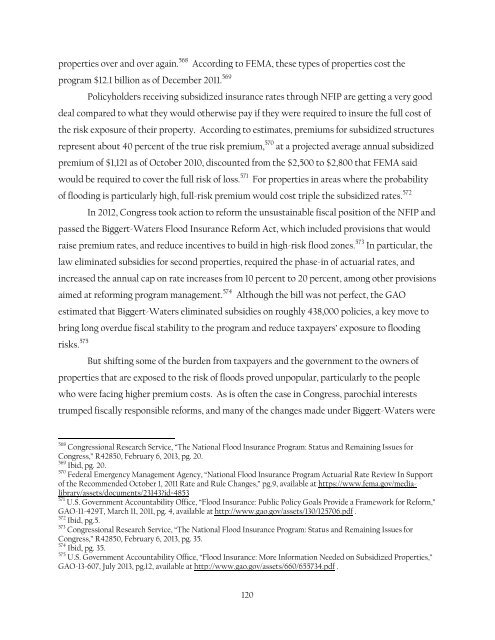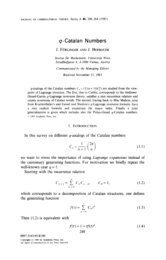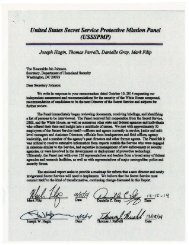010815as1
Create successful ePaper yourself
Turn your PDF publications into a flip-book with our unique Google optimized e-Paper software.
isks. 575 But shifting some of the burden from taxpayers and the government to the owners of<br />
properties over and over again. 568 According to FEMA, these types of properties cost the<br />
program $12.1 billion as of December 2011. 569<br />
Policyholders receiving subsidized insurance rates through NFIP are getting a very good<br />
deal compared to what they would otherwise pay if they were required to insure the full cost of<br />
the risk exposure of their property. According to estimates, premiums for subsidized structures<br />
represent about 40 percent of the true risk premium, 570 at a projected average annual subsidized<br />
premium of $1,121 as of October 2010, discounted from the $2,500 to $2,800 that FEMA said<br />
would be required to cover the full risk of loss. 571 For properties in areas where the probability<br />
of flooding is particularly high, full-risk premium would cost triple the subsidized rates. 572<br />
In 2012, Congress took action to reform the unsustainable fiscal position of the NFIP and<br />
passed the Biggert-Waters Flood Insurance Reform Act, which included provisions that would<br />
raise premium rates, and reduce incentives to build in high-risk flood zones. 573 In particular, the<br />
law eliminated subsidies for second properties, required the phase-in of actuarial rates, and<br />
increased the annual cap on rate increases from 10 percent to 20 percent, among other provisions<br />
aimed at reforming program management. 574 Although the bill was not perfect, the GAO<br />
estimated that Biggert-Waters eliminated subsidies on roughly 438,000 policies, a key move to<br />
bring long overdue fiscal stability to the program and reduce taxpayers’ exposure to flooding<br />
properties that are exposed to the risk of floods proved unpopular, particularly to the people<br />
who were facing higher premium costs. As is often the case in Congress, parochial interests<br />
trumped fiscally responsible reforms, and many of the changes made under Biggert-Waters were<br />
568 Congressional Research Service, “The National Flood Insurance Program: Status and Remaining Issues for<br />
Congress,” R42850, February 6, 2013, pg. 20.<br />
569 Ibid, pg. 20.<br />
570 Federal Emergency Management Agency, “National Flood Insurance Program Actuarial Rate Review In Support<br />
of the Recommended October 1, 2011 Rate and Rule Changes,” pg.9, available at https://www.fema.gov/medialibrary/assets/documents/23143?id=4853<br />
571 U.S. Government Accountability Office, “Flood Insurance: Public Policy Goals Provide a Framework for Reform,”<br />
GAO-11-429T, March 11, 2011, pg. 4, available at http://www.gao.gov/assets/130/125706.pdf .<br />
572 Ibid, pg.5.<br />
573 Congressional Research Service, “The National Flood Insurance Program: Status and Remaining Issues for<br />
Congress,” R42850, February 6, 2013, pg. 35.<br />
574 Ibid, pg. 35.<br />
575 U.S. Government Accountability Office, “Flood Insurance: More Information Needed on Subsidized Properties,”<br />
GAO-13-607, July 2013, pg.12, available at http://www.gao.gov/assets/660/655734.pdf .<br />
120








![55721335-d6fe09eb5ffdcc87dbf6c3f0b5bbda07d2261e98[1]](https://img.yumpu.com/56533583/1/186x260/55721335-d6fe09eb5ffdcc87dbf6c3f0b5bbda07d2261e981.jpg?quality=85)








